Strategic Management Final Exam Questions and Answers
VerifiedAdded on 2021/06/14
|10
|2066
|83
Homework Assignment
AI Summary
This document presents comprehensive solutions to a Strategic Management final exam, encompassing key concepts such as diversification strategies (related and unrelated), acquisition strategies (including problems associated with them), and international business strategies. The solutions delve into the rationale behind diversification, exploring its advantages and disadvantages, and the factors influencing a company's decision to expand into new markets or product lines. The acquisition strategy section examines the process of one company acquiring another, highlighting the benefits and potential pitfalls. Finally, the document discusses the benefits and risks associated with international business strategies, analyzing the impact of environmental trends and economic factors on corporate-level decisions. The answers are well-researched and include references to support the arguments presented.

Qs-Strg Management Final Exam
INSTITUTIONAL AFFILIATION(S)
[Pick the date]
STUDENT NAME
INSTITUTIONAL AFFILIATION(S)
[Pick the date]
STUDENT NAME
Paraphrase This Document
Need a fresh take? Get an instant paraphrase of this document with our AI Paraphraser
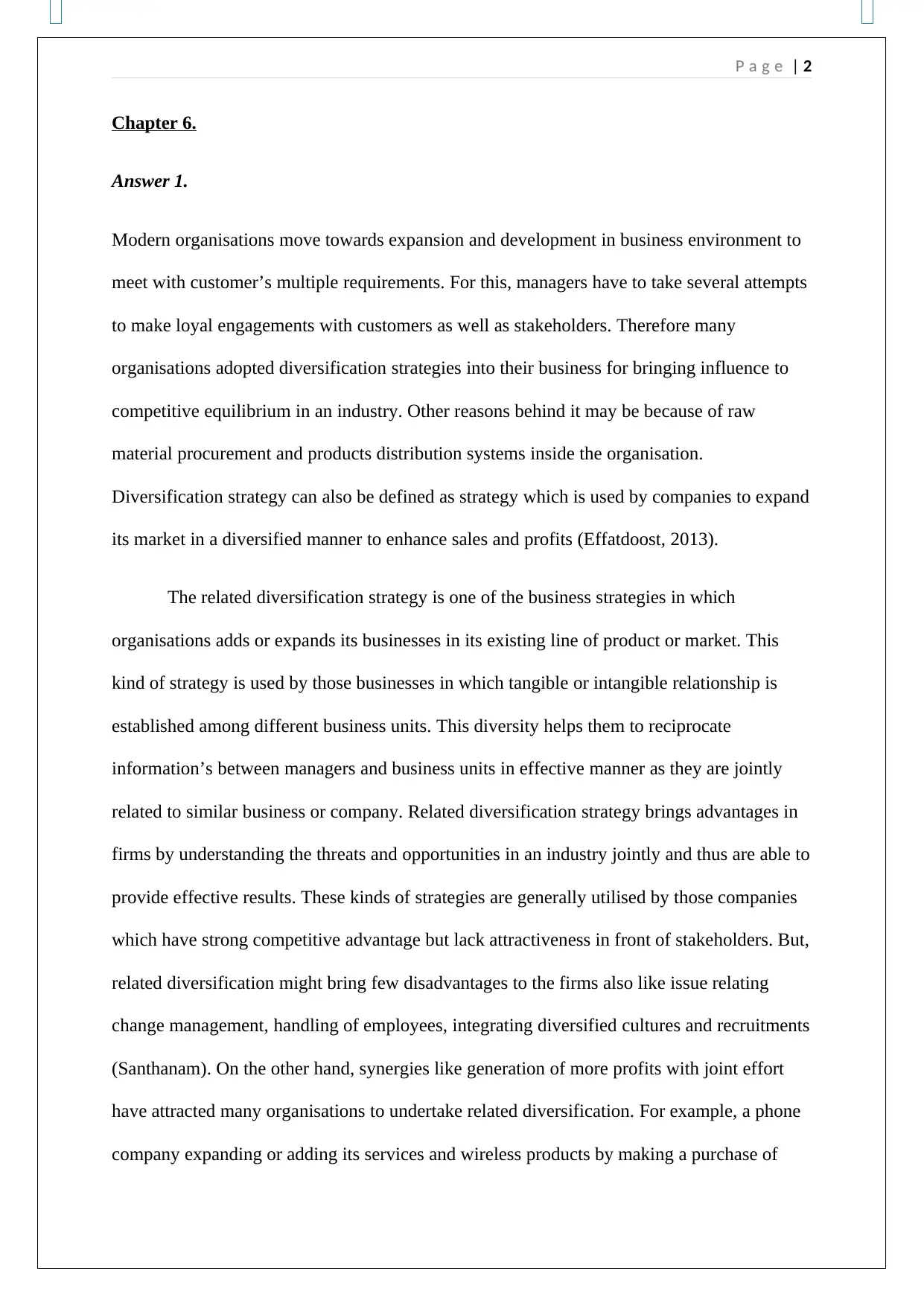
P a g e | 2
Chapter 6.
Answer 1.
Modern organisations move towards expansion and development in business environment to
meet with customer’s multiple requirements. For this, managers have to take several attempts
to make loyal engagements with customers as well as stakeholders. Therefore many
organisations adopted diversification strategies into their business for bringing influence to
competitive equilibrium in an industry. Other reasons behind it may be because of raw
material procurement and products distribution systems inside the organisation.
Diversification strategy can also be defined as strategy which is used by companies to expand
its market in a diversified manner to enhance sales and profits (Effatdoost, 2013).
The related diversification strategy is one of the business strategies in which
organisations adds or expands its businesses in its existing line of product or market. This
kind of strategy is used by those businesses in which tangible or intangible relationship is
established among different business units. This diversity helps them to reciprocate
information’s between managers and business units in effective manner as they are jointly
related to similar business or company. Related diversification strategy brings advantages in
firms by understanding the threats and opportunities in an industry jointly and thus are able to
provide effective results. These kinds of strategies are generally utilised by those companies
which have strong competitive advantage but lack attractiveness in front of stakeholders. But,
related diversification might bring few disadvantages to the firms also like issue relating
change management, handling of employees, integrating diversified cultures and recruitments
(Santhanam). On the other hand, synergies like generation of more profits with joint effort
have attracted many organisations to undertake related diversification. For example, a phone
company expanding or adding its services and wireless products by making a purchase of
Chapter 6.
Answer 1.
Modern organisations move towards expansion and development in business environment to
meet with customer’s multiple requirements. For this, managers have to take several attempts
to make loyal engagements with customers as well as stakeholders. Therefore many
organisations adopted diversification strategies into their business for bringing influence to
competitive equilibrium in an industry. Other reasons behind it may be because of raw
material procurement and products distribution systems inside the organisation.
Diversification strategy can also be defined as strategy which is used by companies to expand
its market in a diversified manner to enhance sales and profits (Effatdoost, 2013).
The related diversification strategy is one of the business strategies in which
organisations adds or expands its businesses in its existing line of product or market. This
kind of strategy is used by those businesses in which tangible or intangible relationship is
established among different business units. This diversity helps them to reciprocate
information’s between managers and business units in effective manner as they are jointly
related to similar business or company. Related diversification strategy brings advantages in
firms by understanding the threats and opportunities in an industry jointly and thus are able to
provide effective results. These kinds of strategies are generally utilised by those companies
which have strong competitive advantage but lack attractiveness in front of stakeholders. But,
related diversification might bring few disadvantages to the firms also like issue relating
change management, handling of employees, integrating diversified cultures and recruitments
(Santhanam). On the other hand, synergies like generation of more profits with joint effort
have attracted many organisations to undertake related diversification. For example, a phone
company expanding or adding its services and wireless products by making a purchase of
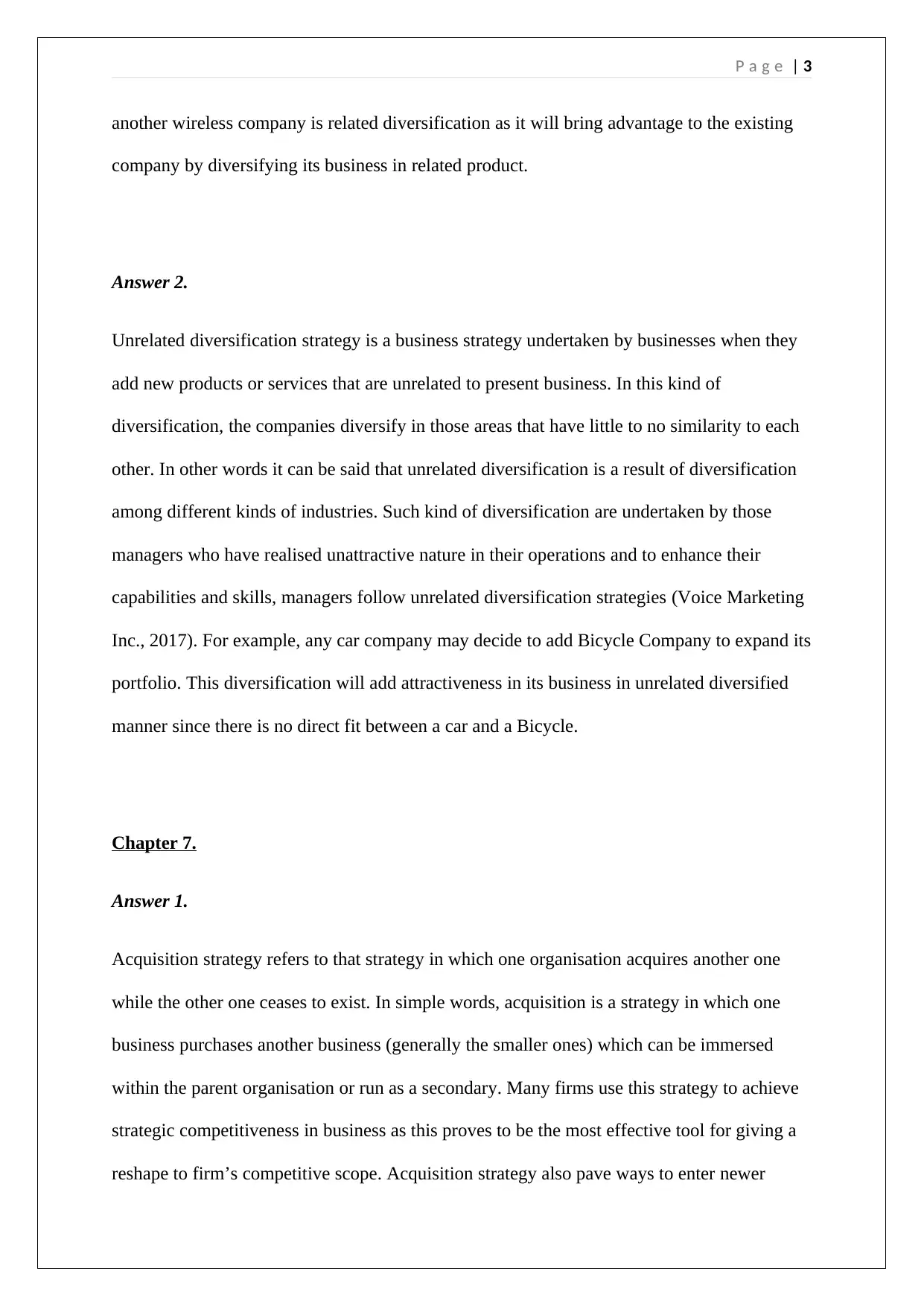
P a g e | 3
another wireless company is related diversification as it will bring advantage to the existing
company by diversifying its business in related product.
Answer 2.
Unrelated diversification strategy is a business strategy undertaken by businesses when they
add new products or services that are unrelated to present business. In this kind of
diversification, the companies diversify in those areas that have little to no similarity to each
other. In other words it can be said that unrelated diversification is a result of diversification
among different kinds of industries. Such kind of diversification are undertaken by those
managers who have realised unattractive nature in their operations and to enhance their
capabilities and skills, managers follow unrelated diversification strategies (Voice Marketing
Inc., 2017). For example, any car company may decide to add Bicycle Company to expand its
portfolio. This diversification will add attractiveness in its business in unrelated diversified
manner since there is no direct fit between a car and a Bicycle.
Chapter 7.
Answer 1.
Acquisition strategy refers to that strategy in which one organisation acquires another one
while the other one ceases to exist. In simple words, acquisition is a strategy in which one
business purchases another business (generally the smaller ones) which can be immersed
within the parent organisation or run as a secondary. Many firms use this strategy to achieve
strategic competitiveness in business as this proves to be the most effective tool for giving a
reshape to firm’s competitive scope. Acquisition strategy also pave ways to enter newer
another wireless company is related diversification as it will bring advantage to the existing
company by diversifying its business in related product.
Answer 2.
Unrelated diversification strategy is a business strategy undertaken by businesses when they
add new products or services that are unrelated to present business. In this kind of
diversification, the companies diversify in those areas that have little to no similarity to each
other. In other words it can be said that unrelated diversification is a result of diversification
among different kinds of industries. Such kind of diversification are undertaken by those
managers who have realised unattractive nature in their operations and to enhance their
capabilities and skills, managers follow unrelated diversification strategies (Voice Marketing
Inc., 2017). For example, any car company may decide to add Bicycle Company to expand its
portfolio. This diversification will add attractiveness in its business in unrelated diversified
manner since there is no direct fit between a car and a Bicycle.
Chapter 7.
Answer 1.
Acquisition strategy refers to that strategy in which one organisation acquires another one
while the other one ceases to exist. In simple words, acquisition is a strategy in which one
business purchases another business (generally the smaller ones) which can be immersed
within the parent organisation or run as a secondary. Many firms use this strategy to achieve
strategic competitiveness in business as this proves to be the most effective tool for giving a
reshape to firm’s competitive scope. Acquisition strategy also pave ways to enter newer
⊘ This is a preview!⊘
Do you want full access?
Subscribe today to unlock all pages.

Trusted by 1+ million students worldwide
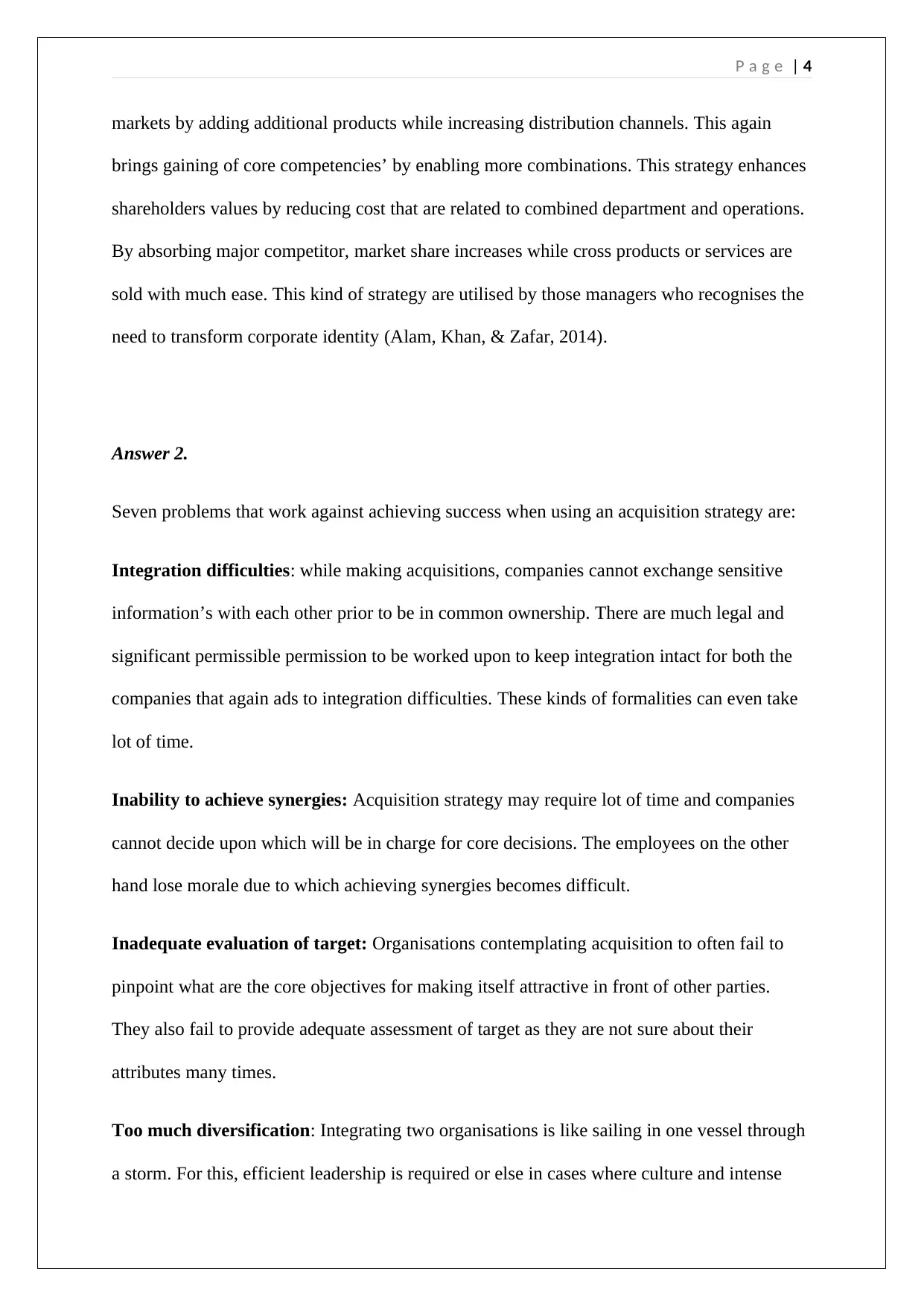
P a g e | 4
markets by adding additional products while increasing distribution channels. This again
brings gaining of core competencies’ by enabling more combinations. This strategy enhances
shareholders values by reducing cost that are related to combined department and operations.
By absorbing major competitor, market share increases while cross products or services are
sold with much ease. This kind of strategy are utilised by those managers who recognises the
need to transform corporate identity (Alam, Khan, & Zafar, 2014).
Answer 2.
Seven problems that work against achieving success when using an acquisition strategy are:
Integration difficulties: while making acquisitions, companies cannot exchange sensitive
information’s with each other prior to be in common ownership. There are much legal and
significant permissible permission to be worked upon to keep integration intact for both the
companies that again ads to integration difficulties. These kinds of formalities can even take
lot of time.
Inability to achieve synergies: Acquisition strategy may require lot of time and companies
cannot decide upon which will be in charge for core decisions. The employees on the other
hand lose morale due to which achieving synergies becomes difficult.
Inadequate evaluation of target: Organisations contemplating acquisition to often fail to
pinpoint what are the core objectives for making itself attractive in front of other parties.
They also fail to provide adequate assessment of target as they are not sure about their
attributes many times.
Too much diversification: Integrating two organisations is like sailing in one vessel through
a storm. For this, efficient leadership is required or else in cases where culture and intense
markets by adding additional products while increasing distribution channels. This again
brings gaining of core competencies’ by enabling more combinations. This strategy enhances
shareholders values by reducing cost that are related to combined department and operations.
By absorbing major competitor, market share increases while cross products or services are
sold with much ease. This kind of strategy are utilised by those managers who recognises the
need to transform corporate identity (Alam, Khan, & Zafar, 2014).
Answer 2.
Seven problems that work against achieving success when using an acquisition strategy are:
Integration difficulties: while making acquisitions, companies cannot exchange sensitive
information’s with each other prior to be in common ownership. There are much legal and
significant permissible permission to be worked upon to keep integration intact for both the
companies that again ads to integration difficulties. These kinds of formalities can even take
lot of time.
Inability to achieve synergies: Acquisition strategy may require lot of time and companies
cannot decide upon which will be in charge for core decisions. The employees on the other
hand lose morale due to which achieving synergies becomes difficult.
Inadequate evaluation of target: Organisations contemplating acquisition to often fail to
pinpoint what are the core objectives for making itself attractive in front of other parties.
They also fail to provide adequate assessment of target as they are not sure about their
attributes many times.
Too much diversification: Integrating two organisations is like sailing in one vessel through
a storm. For this, efficient leadership is required or else in cases where culture and intense
Paraphrase This Document
Need a fresh take? Get an instant paraphrase of this document with our AI Paraphraser
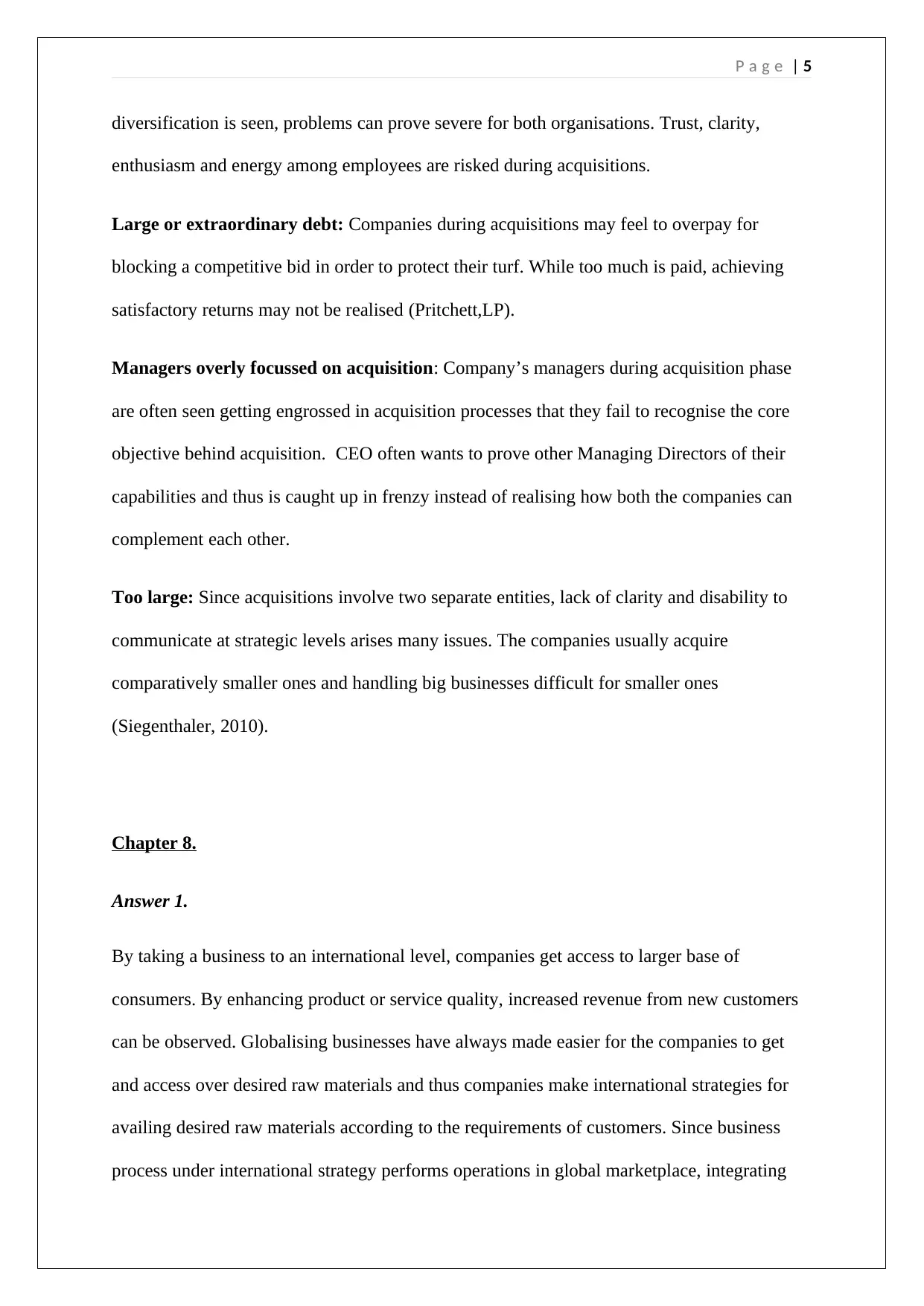
P a g e | 5
diversification is seen, problems can prove severe for both organisations. Trust, clarity,
enthusiasm and energy among employees are risked during acquisitions.
Large or extraordinary debt: Companies during acquisitions may feel to overpay for
blocking a competitive bid in order to protect their turf. While too much is paid, achieving
satisfactory returns may not be realised (Pritchett,LP).
Managers overly focussed on acquisition: Company’s managers during acquisition phase
are often seen getting engrossed in acquisition processes that they fail to recognise the core
objective behind acquisition. CEO often wants to prove other Managing Directors of their
capabilities and thus is caught up in frenzy instead of realising how both the companies can
complement each other.
Too large: Since acquisitions involve two separate entities, lack of clarity and disability to
communicate at strategic levels arises many issues. The companies usually acquire
comparatively smaller ones and handling big businesses difficult for smaller ones
(Siegenthaler, 2010).
Chapter 8.
Answer 1.
By taking a business to an international level, companies get access to larger base of
consumers. By enhancing product or service quality, increased revenue from new customers
can be observed. Globalising businesses have always made easier for the companies to get
and access over desired raw materials and thus companies make international strategies for
availing desired raw materials according to the requirements of customers. Since business
process under international strategy performs operations in global marketplace, integrating
diversification is seen, problems can prove severe for both organisations. Trust, clarity,
enthusiasm and energy among employees are risked during acquisitions.
Large or extraordinary debt: Companies during acquisitions may feel to overpay for
blocking a competitive bid in order to protect their turf. While too much is paid, achieving
satisfactory returns may not be realised (Pritchett,LP).
Managers overly focussed on acquisition: Company’s managers during acquisition phase
are often seen getting engrossed in acquisition processes that they fail to recognise the core
objective behind acquisition. CEO often wants to prove other Managing Directors of their
capabilities and thus is caught up in frenzy instead of realising how both the companies can
complement each other.
Too large: Since acquisitions involve two separate entities, lack of clarity and disability to
communicate at strategic levels arises many issues. The companies usually acquire
comparatively smaller ones and handling big businesses difficult for smaller ones
(Siegenthaler, 2010).
Chapter 8.
Answer 1.
By taking a business to an international level, companies get access to larger base of
consumers. By enhancing product or service quality, increased revenue from new customers
can be observed. Globalising businesses have always made easier for the companies to get
and access over desired raw materials and thus companies make international strategies for
availing desired raw materials according to the requirements of customers. Since business
process under international strategy performs operations in global marketplace, integrating
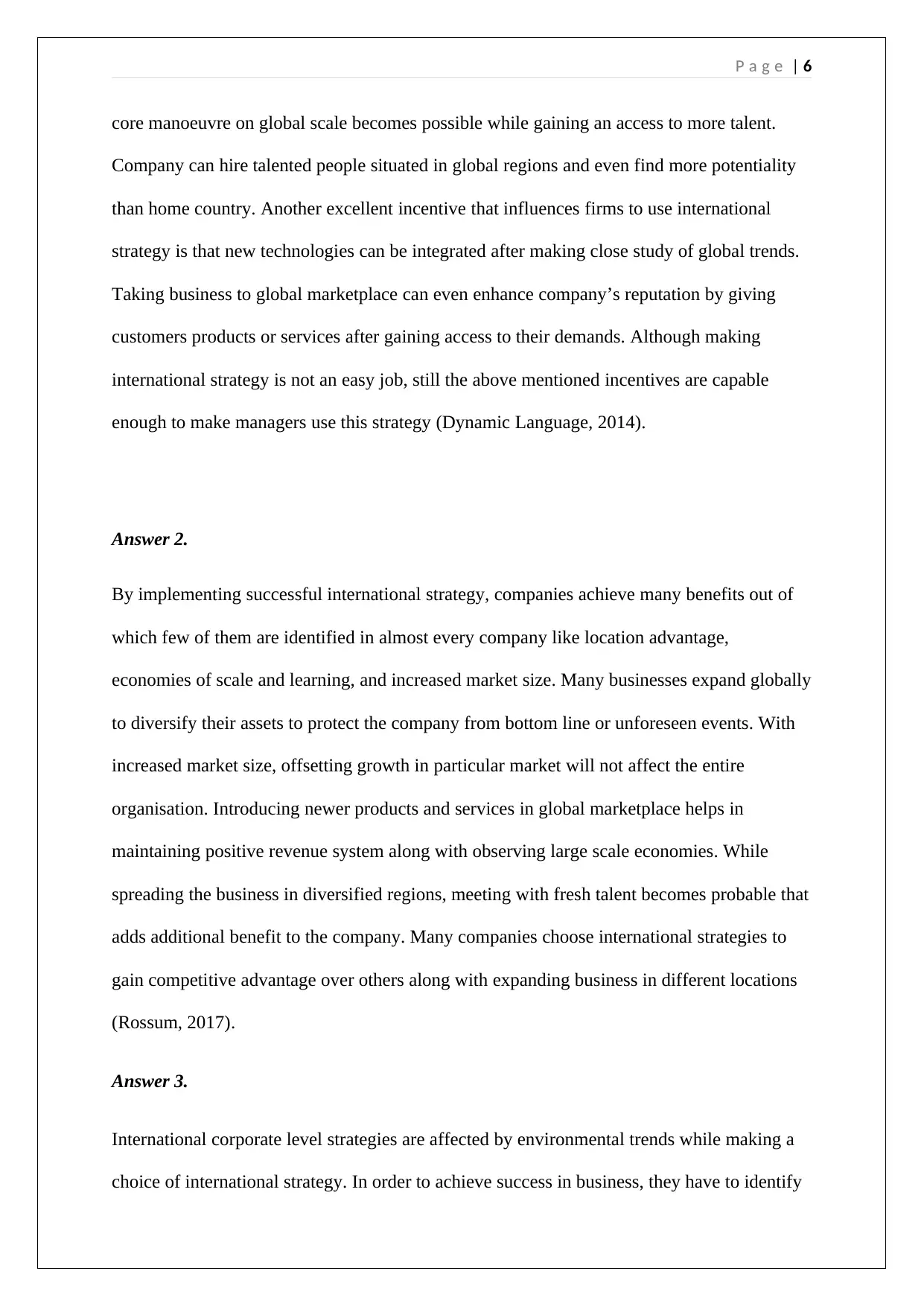
P a g e | 6
core manoeuvre on global scale becomes possible while gaining an access to more talent.
Company can hire talented people situated in global regions and even find more potentiality
than home country. Another excellent incentive that influences firms to use international
strategy is that new technologies can be integrated after making close study of global trends.
Taking business to global marketplace can even enhance company’s reputation by giving
customers products or services after gaining access to their demands. Although making
international strategy is not an easy job, still the above mentioned incentives are capable
enough to make managers use this strategy (Dynamic Language, 2014).
Answer 2.
By implementing successful international strategy, companies achieve many benefits out of
which few of them are identified in almost every company like location advantage,
economies of scale and learning, and increased market size. Many businesses expand globally
to diversify their assets to protect the company from bottom line or unforeseen events. With
increased market size, offsetting growth in particular market will not affect the entire
organisation. Introducing newer products and services in global marketplace helps in
maintaining positive revenue system along with observing large scale economies. While
spreading the business in diversified regions, meeting with fresh talent becomes probable that
adds additional benefit to the company. Many companies choose international strategies to
gain competitive advantage over others along with expanding business in different locations
(Rossum, 2017).
Answer 3.
International corporate level strategies are affected by environmental trends while making a
choice of international strategy. In order to achieve success in business, they have to identify
core manoeuvre on global scale becomes possible while gaining an access to more talent.
Company can hire talented people situated in global regions and even find more potentiality
than home country. Another excellent incentive that influences firms to use international
strategy is that new technologies can be integrated after making close study of global trends.
Taking business to global marketplace can even enhance company’s reputation by giving
customers products or services after gaining access to their demands. Although making
international strategy is not an easy job, still the above mentioned incentives are capable
enough to make managers use this strategy (Dynamic Language, 2014).
Answer 2.
By implementing successful international strategy, companies achieve many benefits out of
which few of them are identified in almost every company like location advantage,
economies of scale and learning, and increased market size. Many businesses expand globally
to diversify their assets to protect the company from bottom line or unforeseen events. With
increased market size, offsetting growth in particular market will not affect the entire
organisation. Introducing newer products and services in global marketplace helps in
maintaining positive revenue system along with observing large scale economies. While
spreading the business in diversified regions, meeting with fresh talent becomes probable that
adds additional benefit to the company. Many companies choose international strategies to
gain competitive advantage over others along with expanding business in different locations
(Rossum, 2017).
Answer 3.
International corporate level strategies are affected by environmental trends while making a
choice of international strategy. In order to achieve success in business, they have to identify
⊘ This is a preview!⊘
Do you want full access?
Subscribe today to unlock all pages.

Trusted by 1+ million students worldwide
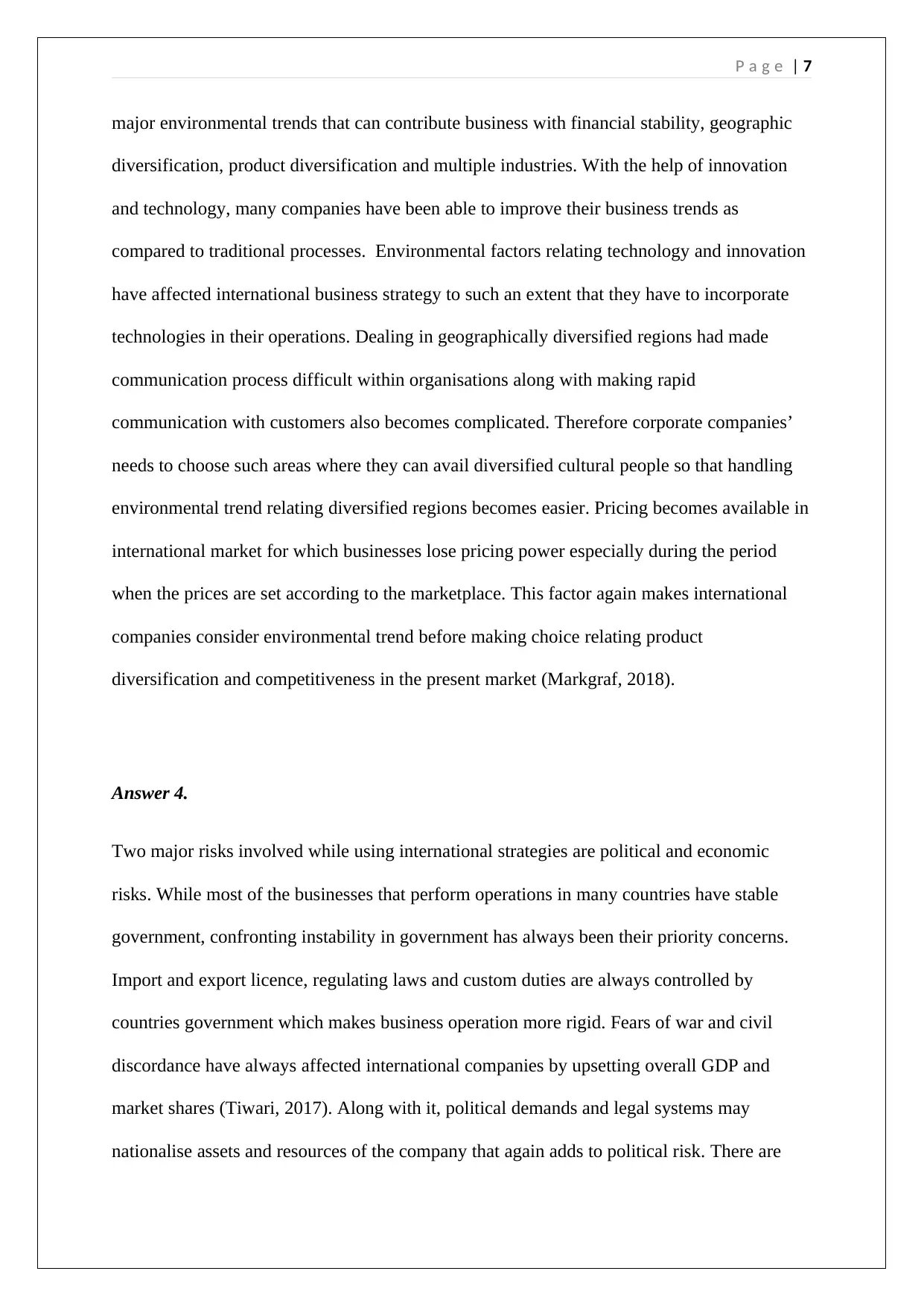
P a g e | 7
major environmental trends that can contribute business with financial stability, geographic
diversification, product diversification and multiple industries. With the help of innovation
and technology, many companies have been able to improve their business trends as
compared to traditional processes. Environmental factors relating technology and innovation
have affected international business strategy to such an extent that they have to incorporate
technologies in their operations. Dealing in geographically diversified regions had made
communication process difficult within organisations along with making rapid
communication with customers also becomes complicated. Therefore corporate companies’
needs to choose such areas where they can avail diversified cultural people so that handling
environmental trend relating diversified regions becomes easier. Pricing becomes available in
international market for which businesses lose pricing power especially during the period
when the prices are set according to the marketplace. This factor again makes international
companies consider environmental trend before making choice relating product
diversification and competitiveness in the present market (Markgraf, 2018).
Answer 4.
Two major risks involved while using international strategies are political and economic
risks. While most of the businesses that perform operations in many countries have stable
government, confronting instability in government has always been their priority concerns.
Import and export licence, regulating laws and custom duties are always controlled by
countries government which makes business operation more rigid. Fears of war and civil
discordance have always affected international companies by upsetting overall GDP and
market shares (Tiwari, 2017). Along with it, political demands and legal systems may
nationalise assets and resources of the company that again adds to political risk. There are
major environmental trends that can contribute business with financial stability, geographic
diversification, product diversification and multiple industries. With the help of innovation
and technology, many companies have been able to improve their business trends as
compared to traditional processes. Environmental factors relating technology and innovation
have affected international business strategy to such an extent that they have to incorporate
technologies in their operations. Dealing in geographically diversified regions had made
communication process difficult within organisations along with making rapid
communication with customers also becomes complicated. Therefore corporate companies’
needs to choose such areas where they can avail diversified cultural people so that handling
environmental trend relating diversified regions becomes easier. Pricing becomes available in
international market for which businesses lose pricing power especially during the period
when the prices are set according to the marketplace. This factor again makes international
companies consider environmental trend before making choice relating product
diversification and competitiveness in the present market (Markgraf, 2018).
Answer 4.
Two major risks involved while using international strategies are political and economic
risks. While most of the businesses that perform operations in many countries have stable
government, confronting instability in government has always been their priority concerns.
Import and export licence, regulating laws and custom duties are always controlled by
countries government which makes business operation more rigid. Fears of war and civil
discordance have always affected international companies by upsetting overall GDP and
market shares (Tiwari, 2017). Along with it, political demands and legal systems may
nationalise assets and resources of the company that again adds to political risk. There are
Paraphrase This Document
Need a fresh take? Get an instant paraphrase of this document with our AI Paraphraser
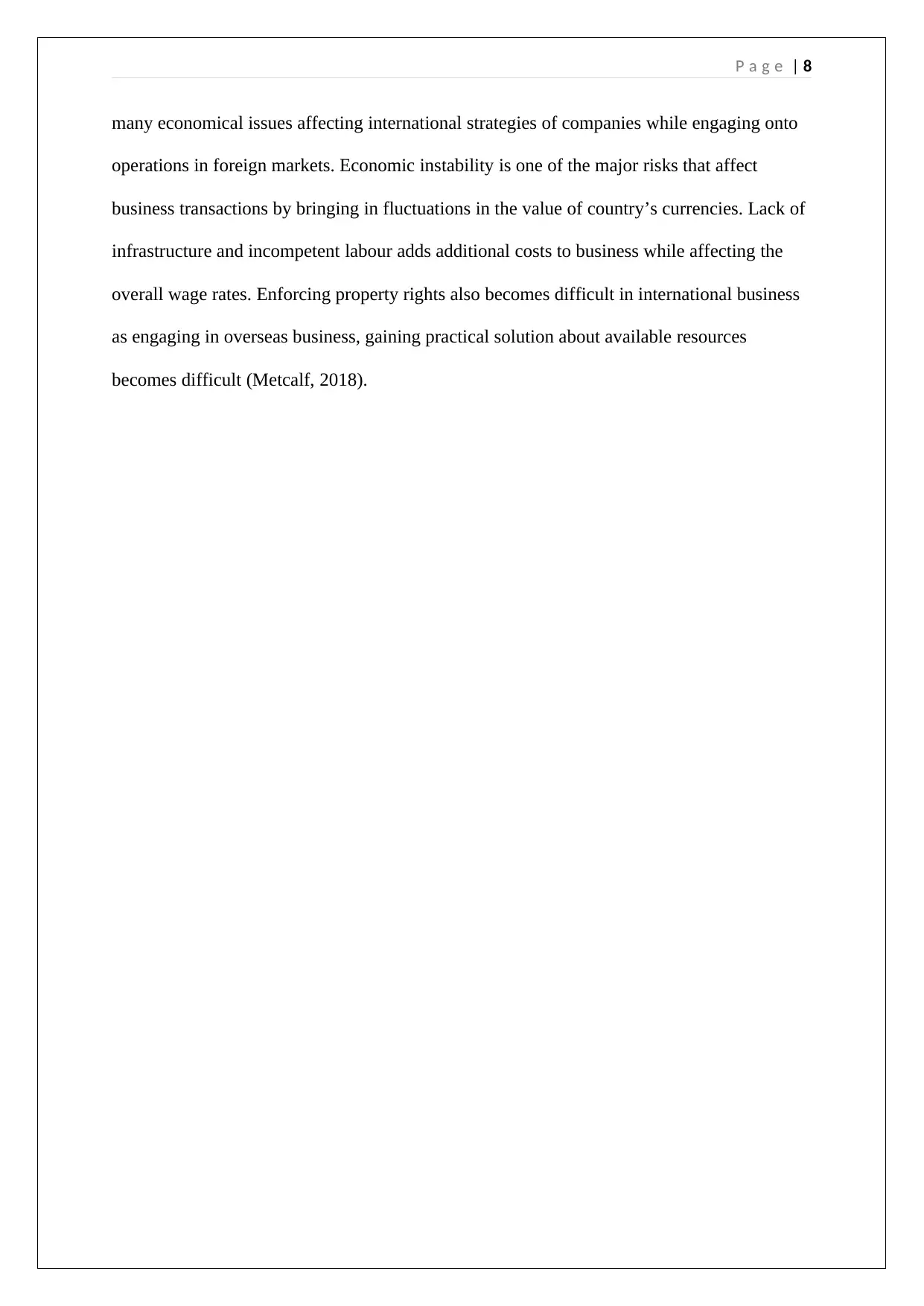
P a g e | 8
many economical issues affecting international strategies of companies while engaging onto
operations in foreign markets. Economic instability is one of the major risks that affect
business transactions by bringing in fluctuations in the value of country’s currencies. Lack of
infrastructure and incompetent labour adds additional costs to business while affecting the
overall wage rates. Enforcing property rights also becomes difficult in international business
as engaging in overseas business, gaining practical solution about available resources
becomes difficult (Metcalf, 2018).
many economical issues affecting international strategies of companies while engaging onto
operations in foreign markets. Economic instability is one of the major risks that affect
business transactions by bringing in fluctuations in the value of country’s currencies. Lack of
infrastructure and incompetent labour adds additional costs to business while affecting the
overall wage rates. Enforcing property rights also becomes difficult in international business
as engaging in overseas business, gaining practical solution about available resources
becomes difficult (Metcalf, 2018).
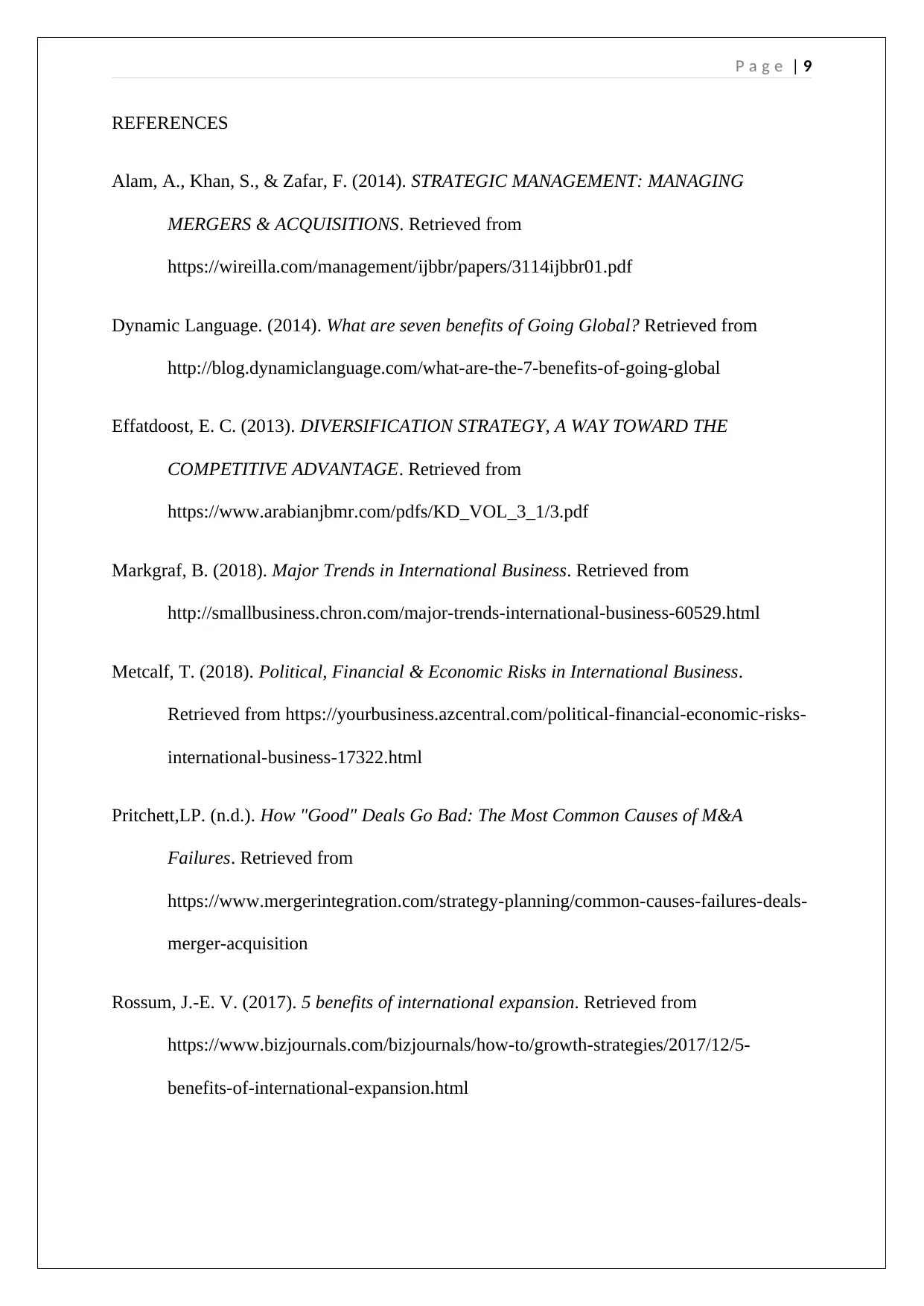
P a g e | 9
REFERENCES
Alam, A., Khan, S., & Zafar, F. (2014). STRATEGIC MANAGEMENT: MANAGING
MERGERS & ACQUISITIONS. Retrieved from
https://wireilla.com/management/ijbbr/papers/3114ijbbr01.pdf
Dynamic Language. (2014). What are seven benefits of Going Global? Retrieved from
http://blog.dynamiclanguage.com/what-are-the-7-benefits-of-going-global
Effatdoost, E. C. (2013). DIVERSIFICATION STRATEGY, A WAY TOWARD THE
COMPETITIVE ADVANTAGE. Retrieved from
https://www.arabianjbmr.com/pdfs/KD_VOL_3_1/3.pdf
Markgraf, B. (2018). Major Trends in International Business. Retrieved from
http://smallbusiness.chron.com/major-trends-international-business-60529.html
Metcalf, T. (2018). Political, Financial & Economic Risks in International Business.
Retrieved from https://yourbusiness.azcentral.com/political-financial-economic-risks-
international-business-17322.html
Pritchett,LP. (n.d.). How "Good" Deals Go Bad: The Most Common Causes of M&A
Failures. Retrieved from
https://www.mergerintegration.com/strategy-planning/common-causes-failures-deals-
merger-acquisition
Rossum, J.-E. V. (2017). 5 benefits of international expansion. Retrieved from
https://www.bizjournals.com/bizjournals/how-to/growth-strategies/2017/12/5-
benefits-of-international-expansion.html
REFERENCES
Alam, A., Khan, S., & Zafar, F. (2014). STRATEGIC MANAGEMENT: MANAGING
MERGERS & ACQUISITIONS. Retrieved from
https://wireilla.com/management/ijbbr/papers/3114ijbbr01.pdf
Dynamic Language. (2014). What are seven benefits of Going Global? Retrieved from
http://blog.dynamiclanguage.com/what-are-the-7-benefits-of-going-global
Effatdoost, E. C. (2013). DIVERSIFICATION STRATEGY, A WAY TOWARD THE
COMPETITIVE ADVANTAGE. Retrieved from
https://www.arabianjbmr.com/pdfs/KD_VOL_3_1/3.pdf
Markgraf, B. (2018). Major Trends in International Business. Retrieved from
http://smallbusiness.chron.com/major-trends-international-business-60529.html
Metcalf, T. (2018). Political, Financial & Economic Risks in International Business.
Retrieved from https://yourbusiness.azcentral.com/political-financial-economic-risks-
international-business-17322.html
Pritchett,LP. (n.d.). How "Good" Deals Go Bad: The Most Common Causes of M&A
Failures. Retrieved from
https://www.mergerintegration.com/strategy-planning/common-causes-failures-deals-
merger-acquisition
Rossum, J.-E. V. (2017). 5 benefits of international expansion. Retrieved from
https://www.bizjournals.com/bizjournals/how-to/growth-strategies/2017/12/5-
benefits-of-international-expansion.html
⊘ This is a preview!⊘
Do you want full access?
Subscribe today to unlock all pages.

Trusted by 1+ million students worldwide
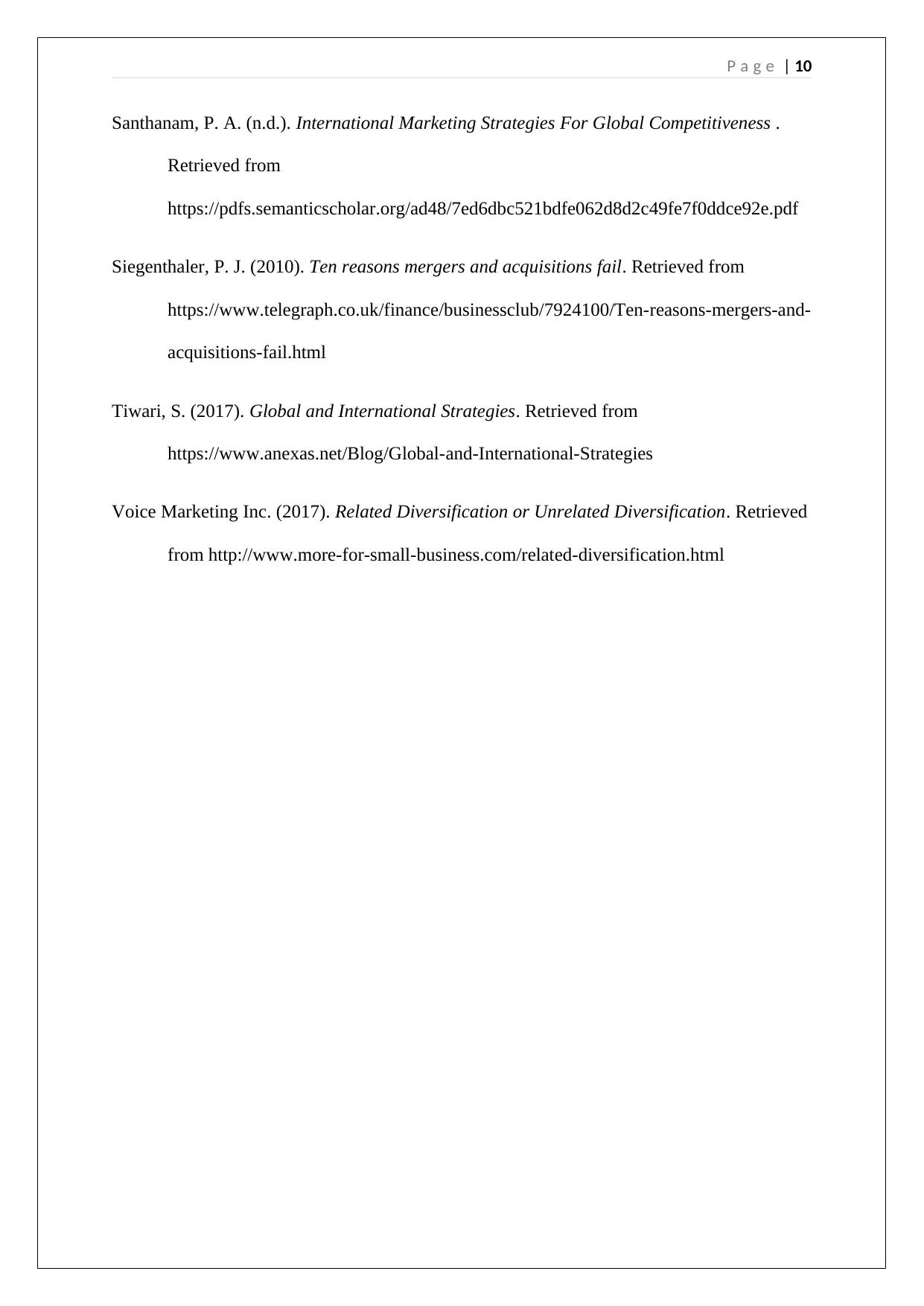
P a g e | 10
Santhanam, P. A. (n.d.). International Marketing Strategies For Global Competitiveness .
Retrieved from
https://pdfs.semanticscholar.org/ad48/7ed6dbc521bdfe062d8d2c49fe7f0ddce92e.pdf
Siegenthaler, P. J. (2010). Ten reasons mergers and acquisitions fail. Retrieved from
https://www.telegraph.co.uk/finance/businessclub/7924100/Ten-reasons-mergers-and-
acquisitions-fail.html
Tiwari, S. (2017). Global and International Strategies. Retrieved from
https://www.anexas.net/Blog/Global-and-International-Strategies
Voice Marketing Inc. (2017). Related Diversification or Unrelated Diversification. Retrieved
from http://www.more-for-small-business.com/related-diversification.html
Santhanam, P. A. (n.d.). International Marketing Strategies For Global Competitiveness .
Retrieved from
https://pdfs.semanticscholar.org/ad48/7ed6dbc521bdfe062d8d2c49fe7f0ddce92e.pdf
Siegenthaler, P. J. (2010). Ten reasons mergers and acquisitions fail. Retrieved from
https://www.telegraph.co.uk/finance/businessclub/7924100/Ten-reasons-mergers-and-
acquisitions-fail.html
Tiwari, S. (2017). Global and International Strategies. Retrieved from
https://www.anexas.net/Blog/Global-and-International-Strategies
Voice Marketing Inc. (2017). Related Diversification or Unrelated Diversification. Retrieved
from http://www.more-for-small-business.com/related-diversification.html
1 out of 10
Related Documents
Your All-in-One AI-Powered Toolkit for Academic Success.
+13062052269
info@desklib.com
Available 24*7 on WhatsApp / Email
![[object Object]](/_next/static/media/star-bottom.7253800d.svg)
Unlock your academic potential
Copyright © 2020–2025 A2Z Services. All Rights Reserved. Developed and managed by ZUCOL.





